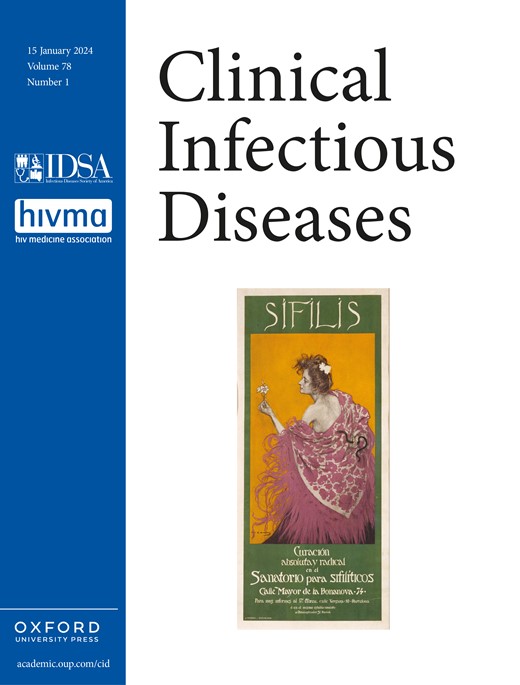北美结核病患者的利奈唑胺剂量和药代动力学
IF 8.2
1区 医学
Q1 IMMUNOLOGY
引用次数: 0
摘要
利奈唑胺被推荐用于利福平或耐多药结核病的治疗方案。然而,存在相当大的药代动力学变异性,长期使用受到不良反应的限制。本研究评估了利奈唑胺在国际治疗药物监测服务肺结核患者中的药代动力学。方法采用美国佛罗里达大学传染病药代动力学实验室对北美地区利奈唑胺给药期、给药后2小时和6小时临床样品进行检测。采用液相色谱-串联质谱法测定血清总浓度。进行治疗药物监测,并将测量值与典型的利奈唑胺浓度进行比较,其中谷值为2微克/毫升,峰值在12至26微克/毫升之间。结果2019年1月至2023年12月,分析了500例患者的1,604份利奈唑胺样本和817种独特的TDM病例。670个样品的谷浓度(中位数为1.19 mcg/mL[范围为0.00-20.06]),232个(34.6%)谷浓度为2 mcg/mL。在利奈唑胺给药600mg /日或5天/周的谷样中,43.2%为2 mcg/mL。在600个峰值样品中,264个(44%)超出了典型范围,大多数(89%)在12微克/毫升时处于亚治疗状态。结论利奈唑胺谷浓度偏高的样本约占三分之一,服用推荐剂量者超过40%。超过40%的峰值浓度超出典型范围,89%的峰值浓度为12微克/毫升。本研究表明,治疗药物监测可用于识别血清利奈唑胺浓度超出目标范围的患者,使临床医生能够做出适当的剂量调整以改善结果。本文章由计算机程序翻译,如有差异,请以英文原文为准。
Linezolid Dosing and Pharmacokinetics in North American Patients with Tuberculosis
Introduction Linezolid is recommended in treatment regimens for rifampin- or multi-drug-resistant tuberculosis. However, considerable pharmacokinetic variability exists, and long-term use is limited by adverse effects. This study evaluates the pharmacokinetics of linezolid in patients with tuberculosis from an international therapeutic drug monitoring service. Methods Linezolid trough, 2-hour, and 6-hour post-dose clinical samples from across North America were tested by the University of Florida Infectious Disease Pharmacokinetics Laboratory. Total serum concentrations were measured using liquid chromatography-tandem mass spectrometry. Therapeutic drug monitoring was performed, and measurements were compared to typical linezolid concentrations including a trough value of <2 mcg/mL and peak value between 12 and 26 mcg/mL. Results From January 2019 to December 2023, 1,604 linezolid samples from 500 patients and 817 unique TDM occasions were analyzed. Trough concentrations were measured on 670 samples (median 1.19 mcg/mL [range 0.00-20.06]), and 232 troughs (34.6%) were >2 mcg/mL. Among trough samples from linezolid dosing of 600mg daily or 5 days/weekly, 43.2% were >2 mcg/mL. Of 600 peak samples, 264 (44%) were outside the typical range, most (89%) being subtherapeutic at <12 mcg/mL. Conclusion High serum linezolid trough concentrations were measured in approximately one-third of samples and in more than 40% of those taking the recommended dose. More than 40% of peak concentrations were outside typical range, 89% of which were <12 mcg/mL. This study demonstrates that therapeutic drug monitoring can be used to identify patients with serum linezolid concentrations outside of targeted ranges, allowing clinicians to make appropriate dose adjustments to improve outcomes.
求助全文
通过发布文献求助,成功后即可免费获取论文全文。
去求助
来源期刊

Clinical Infectious Diseases
医学-传染病学
CiteScore
25.00
自引率
2.50%
发文量
900
审稿时长
3 months
期刊介绍:
Clinical Infectious Diseases (CID) is dedicated to publishing original research, reviews, guidelines, and perspectives with the potential to reshape clinical practice, providing clinicians with valuable insights for patient care. CID comprehensively addresses the clinical presentation, diagnosis, treatment, and prevention of a wide spectrum of infectious diseases. The journal places a high priority on the assessment of current and innovative treatments, microbiology, immunology, and policies, ensuring relevance to patient care in its commitment to advancing the field of infectious diseases.
 求助内容:
求助内容: 应助结果提醒方式:
应助结果提醒方式:


